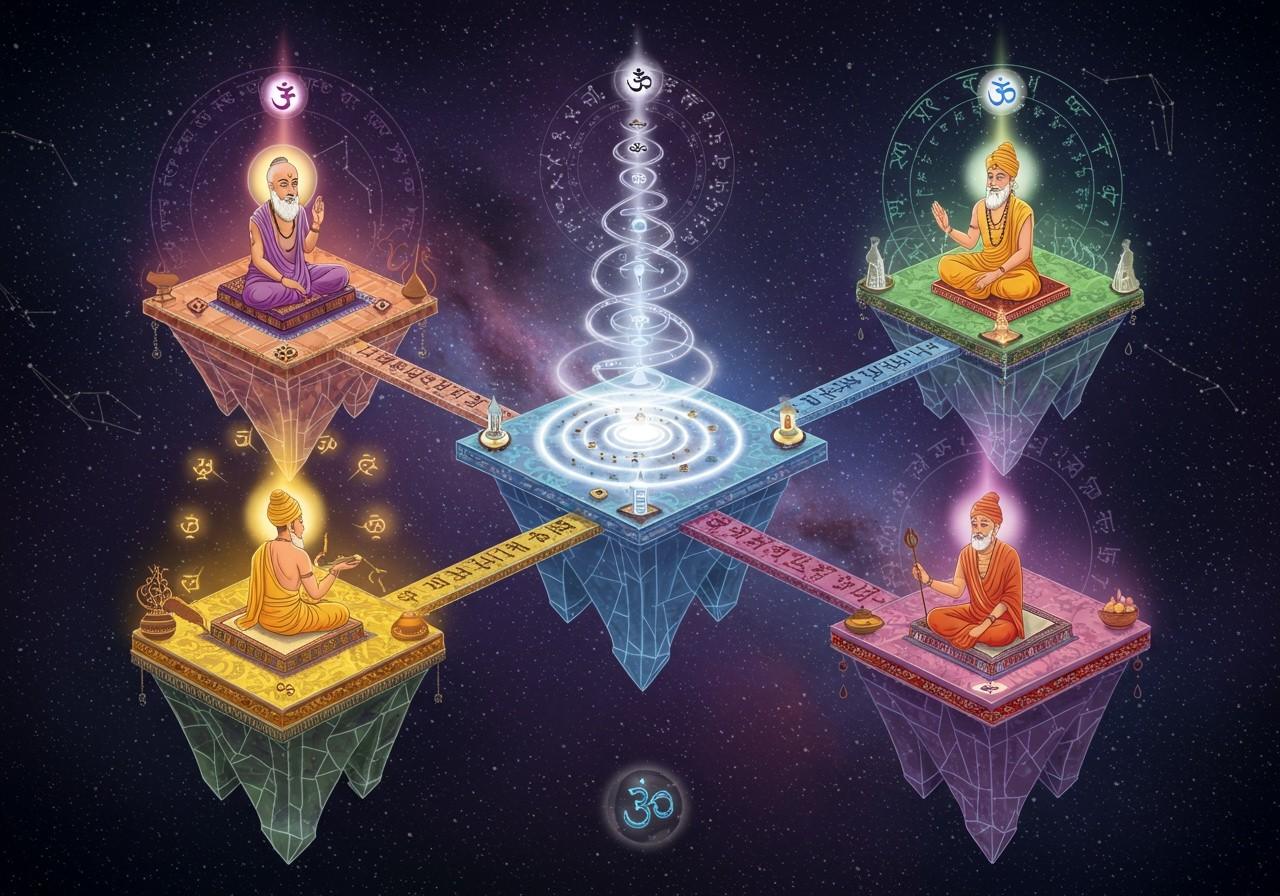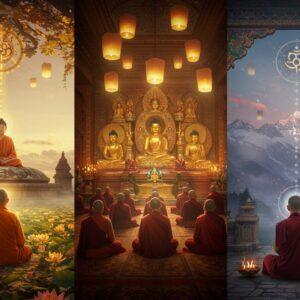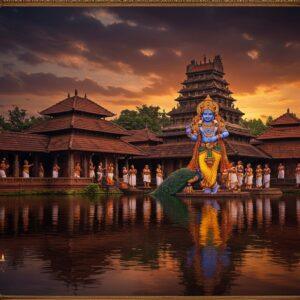
India’s philosophical heritage is a tapestry of diverse traditions, each offering unique perspectives on existence, consciousness, and the path to liberation. Among these, Samkhya stands out as one of the oldest and most influential schools of thought. This exploration delves into the core principles of Samkhya, comparing and contrasting it with other prominent Indian philosophical systems, especially Vedanta and Advaita.
Unveiling the Essence of Samkhya
Samkhya presents a dualistic worldview, distinguishing between Purusha (pure consciousness) and Prakriti (the material world). Understanding Prakriti’s dynamic nature is crucial, and this is where the three Gunas—Sattva (purity, goodness), Rajas (passion, activity), and Tamas (inertia, ignorance)—come into play. They represent the fundamental qualities that constitute and govern the material world. Unlike many other philosophies, Samkhya does not posit a creator god. Liberation (Moksha) is achieved through the realization of the true nature of Purusha, distinct and separate from Prakriti. The Samkhya Karika, an ancient text, serves as a foundational scripture for this school of thought. Explore more about related concepts in our article on connecting with your inner self through Hindu philosophy.
Samkhya and Vedanta: A Philosophical Dialogue
Samkhya and Vedanta offer contrasting perspectives. Samkhya’s dualism stands in contrast to Vedanta’s emphasis on Brahman as the ultimate, singular reality. Specifically, Advaita Vedanta propounds non-dualism, asserting the identity of Atman (individual self) with Brahman. This differs significantly from Samkhya’s dualistic view. While the Upanishads and interpretations by scholars like Adi Shankaracharya are central to Vedanta, Samkhya relies on its own unique epistemology and soteriology. Both schools address Moksha, but their paths diverge – Samkhya through the disentanglement of Purusha from Prakriti, and Vedanta through the realization of the Atman’s unity with Brahman. You can delve deeper into Hindu philosophy with our beginner’s guide.
Samkhya and Advaita: A Comparative Lens
The differences between Samkhya and Advaita Vedanta are substantial. Advaita emphasizes non-dualism and views the world as Maya (illusion). Samkhya, however, rejects the concept of Maya, asserting the real and independent existence of both consciousness (Purusha) and matter (Prakriti). Liberation in Advaita is achieved through the realization of non-duality, whereas in Samkhya, it is attained through the clear distinction between Purusha and Prakriti. These different approaches highlight the diversity and richness of Indian philosophical thought. Further explore the meaning and importance of Hindu symbols in our dedicated article.
Points of Intersection: Samkhya and Advaita Vedanta
Despite their differences, both Samkhya and Advaita Vedanta share some common ground. Both emphasize self-realization and liberation from the cycle of birth and death (samsara). They acknowledge the illusory nature of worldly attachments and stress the importance of inner knowledge for true freedom. Historically, there has been interaction and mutual influence between these two schools, contributing to the overall development of Indian spiritual thought and practice, particularly in the realm of Yoga. Embark on a virtual pilgrimage with our Siddhatek pilgrimage guide.
Cultural Relevance and Practical Application
In contemporary India, these philosophies continue to hold deep cultural significance. They influence various spiritual practices, including yoga and meditation, resonating with those seeking a connection to tradition and authenticity. For many, especially within the middle and upper-middle classes, these philosophies offer practical guidance for navigating life’s complexities and engaging in contemporary ethical discussions.
Supporting Your Spiritual Journey with Poojn.in
Poojn.in, India’s leading online store for cultural and spiritual goods, offers a wide range of products to support your exploration of Indian philosophies, including Samkhya. We provide:
- Sacred Texts and Treatises: Deepen your understanding of Samkhya and other philosophical systems with our collection of authoritative texts. These resources offer invaluable insights into the core principles and practices of these traditions. Browse our selection of holy books.
- Meditation Aids: Enhance your meditation practice with traditional items such as brass diyas, incense holders, and comfortable meditation cushions. Create a serene and conducive environment for contemplation and self-reflection. Explore our meditation aids.
- Ritual Items: Discover authentic ritual items crafted from pure copper and brass, including Vamavarti Shankh (left-spiraling conch shells) for spiritual ceremonies. Find ritual items here.
- Copper Water Vessels: Practice mindful consumption with our pure copper water vessels, traditionally used in many spiritual practices. Shop for copper vessels now.
Visit Poojn.in today to explore our complete collection of authentic and ethically sourced products that can enrich your spiritual journey. All items come with authenticity certificates and detailed usage instructions.
Embracing the Wisdom of Indian Philosophy
Indian philosophy, with its intricate and profound teachings, offers a wealth of wisdom for navigating life’s journey. Samkhya, Vedanta, and Advaita, while distinct in their approaches, all contribute to a deeper understanding of ourselves and the universe. They invite us to embark on a quest for self-realization and liberation, offering solace and guidance in a world of constant change. By embracing these ancient traditions, we can connect with a rich spiritual heritage and discover a path towards inner peace and fulfillment.
Frequently Asked Questions about Samkhya and Other Indian Philosophical Schools
What distinguishes Samkhya from Vedanta? Samkhya embraces dualism, recognizing Purusha (consciousness) and Prakriti (matter) as distinct realities. Vedanta, particularly Advaita Vedanta, champions non-dualism, asserting the unity of all existence in Brahman.
How does Samkhya define liberation? In Samkhya, liberation (Moksha) is achieved by realizing the fundamental separation between Purusha and Prakriti. This realization frees the individual from the cycle of birth and death.
What makes Samkhya unique in the landscape of Indian philosophy? Samkhya’s uniqueness lies in its non-theistic approach. It does not rely on the concept of a personal god, focusing instead on the principles of evolution and the interaction of Purusha and Prakriti.
What common ground do Samkhya and Yoga share? Both Samkhya and Yoga acknowledge the distinction between Purusha and Prakriti. Yoga adopts Samkhya’s metaphysical framework but incorporates practices like meditation and ethical disciplines as a means to achieve liberation.
How does Advaita Vedanta contrast with Samkhya? Advaita Vedanta asserts the non-dual nature of reality, identifying the individual self (Atman) with the ultimate reality (Brahman). Samkhya, conversely, maintains a clear distinction between consciousness (Purusha) and matter (Prakriti).
What is the role of Prakriti in Samkhya philosophy? Prakriti is the material cause of the universe in Samkhya. It is the dynamic force responsible for creation and is composed of the three gunas: sattva, rajas, and tamas.
Are there connections between Samkhya and Buddhism? While both Samkhya and Buddhism aim for liberation from suffering, their paths diverge. Samkhya emphasizes self-knowledge, while Buddhism focuses on the Four Noble Truths, the Eightfold Path, and the concept of impermanence (anicca).


